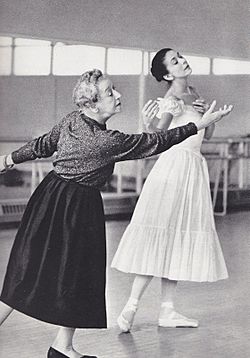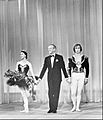Margot Fonteyn facts for kids
Quick facts for kids
Dame Margot Fonteyn DBE
|
|
|---|---|

Two prima ballerinas: Tamara Karsavina rehearsing Margot Fonteyn for Le Spectre de la Rose
|
|
| Born |
Margaret Hookham
18 May 1919 |
| Died | 21 February 1991 (aged 71) |
| Cause of death | Cancer |
| Resting place | Panama |
| Nationality | British |
| Occupation | Ballerina |
| Employer | Royal Ballet |
| Known for | dancing |
| Title | Prima ballerina assoluta |
| Spouse(s) | Roberto Arias (m. 1955-1989, his death) |
Dame Margot Fonteyn (born Margaret Hookham; 18 May 1919 – 21 February 1991) was a famous English ballerina. She spent her whole dancing career with the Royal Ballet. Later, Queen Elizabeth II gave her the special title of prima ballerina assoluta. This means she was considered the very best ballerina of her time.
Contents
Early Life and Training
Margaret Evelyn Hookham was born on 18 May 1919 in Reigate, Surrey, England. Her father, Felix John Hookham, was a British engineer. Her mother, Hilda, was very supportive of Margaret's dancing.
When Margaret was four, her mother sent her and her older brother, Felix, to ballet classes. Her mother even learned the basic steps with her. Hilda was always there to support and guide her daughter. Teachers and colleagues called her "Black Queen" because she was always backstage. Margaret was happy to have her mother's help.
At age five, Margaret danced in a charity show. A newspaper said she gave "a remarkably fine solo." Even as a child, Margaret felt pressure to do well. Before dance exams, she would often get a fever.
Her family moved often because of her father's work. First, they went to Louisville, Kentucky, in the United States. Then, when Margaret was nine, they moved to China.
In Shanghai, China, Margaret studied ballet with Georgy Goncharov. She was not sure she wanted to be a dancer, but she was competitive. She worked harder because another student, June Brae, was in her classes. Margaret preferred the flowing Russian style of ballet.
When she was 14, her mother brought her back to London to become a professional ballet dancer. Margaret began studying with Serafina Astafieva. Soon, Dame Ninette de Valois noticed her talent. She invited Margaret to join the Vic-Wells Ballet School, which later became the Royal Ballet.
Margaret first performed a solo in 1933. She used the stage name Margot Fontes. In 1934, she danced as a snowflake in The Nutcracker. Her family chose the name Fonteyn, which sounded more British, from her mother's family name "Fontes". Her brother, Felix, who became a dance photographer, also used the name Fonteyn.
A Star Ballerina's Career
Margot Fonteyn became the main ballerina of the Vic-Wells company in 1935. The company's main choreographer, Sir Frederick Ashton, created many famous roles for Fonteyn. She often danced with her partner, Robert Helpmann, from the 1930s to the 1940s.
In 1946, the company, now called the Sadler's Wells Ballet, moved to the Royal Opera House in London. For the next ten years, Fonteyn's main partner was Michael Somes. Her performance in Tchaikovsky’s The Sleeping Beauty became very famous. She also starred in ballets created by Ashton, like Symphonic Variations and Cinderella.
In 1949, Fonteyn led the company on a tour of the United States. She became a worldwide celebrity. She also appeared on TV shows like The Ed Sullivan Show, which helped make ballet more popular in the United States.
In 1955, she married Roberto Arias, a politician from Panama. Three years later, she and Somes danced in a BBC television version of The Nutcracker. Because she was so famous, the Royal Ballet allowed Fonteyn to dance as a guest artist for other companies starting in 1959.
In 1961, Fonteyn was thinking about retiring. But then, Rudolf Nureyev, a brilliant dancer, came to the Royal Ballet. Fonteyn was not sure about dancing with him because he was 19 years younger. However, they danced together for the first time in Giselle on 21 February 1962.
They immediately became a huge sensation around the world. Each dancer pushed the other to perform their very best. They were famous for their classical performances in ballets like Swan Lake and La Bayadère. Ashton even created a ballet just for them, Marguerite and Armand. They also starred in Sir Kenneth MacMillan's Romeo and Juliet.
In 1963, Fonteyn's husband was injured and needed constant care for the rest of his life. Fonteyn continued to dance to support her family. In 1972, she began to dance less often, but she still performed until the end of the 1970s.
In 1979, the Royal Ballet honored her. They officially called her the prima ballerina assoluta of the company. She then retired to Panama, where she wrote books, raised cattle, and cared for her husband.
Later Life and Legacy
Margot Fonteyn died on 21 February 1991 in Panama City. She was 71 years old. She was buried next to her husband in Panama. A special service was held for her in London at Westminster Abbey.
In her hometown of Reigate, England, there is a bronze statue of Fonteyn. It shows her in one of her favorite roles, "Ondine." Many places are named after her, including the Fonteyn Ballroom at Durham University. A dance shop in Georgia, USA, called Margot's Closet is also named in her honor. The Margot Fonteyn Academy of Ballet in New York was established in 2007.
In 1996, Fonteyn was one of five "Women of Achievement" chosen for a set of British stamps. Films and documentaries have also been made about her life. In 2016, a special blue plaque was placed on the building where Fonteyn lived in London. Another blue plaque was added to her childhood home in Ealing to mark 100 years since her birth.
Images for kids
-
At a rehearsal for The Ed Sullivan Show in 1953
-
Fonteyn, Fred Astaire and Nureyev on The Hollywood Palace television show, 1965
See also
 In Spanish: Margot Fonteyn para niños
In Spanish: Margot Fonteyn para niños










